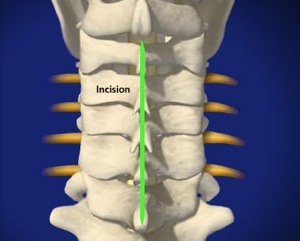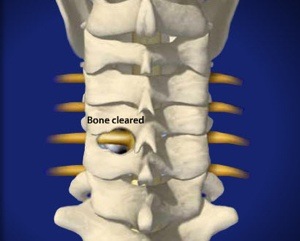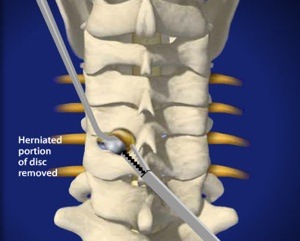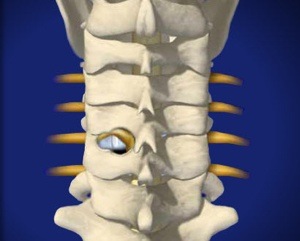Cervical Foraminotomy: surgical procedure to relieve pressure on spinal nerves by widening area around those nerves.

What is a Cervical Foraminotomy?
A foraminotomy is a surgical procedure performed to relieve pressure on spinal nerves as they exit the spine through an opening known as the foramen. When this surgery is performed in the neck region, it is known as cervical foraminotomy. This is a minimally invasive procedure for widening the area where the spinal nerve roots exit the spinal column.
Who needs a Cervical Foraminotomy?
Cervical Foraminotomy is suggested for patients who have bone spurs or herniated discs that are causing cervical nerve root compression. Symptoms of cervical nerve root compression include pain in neck and shoulders. Pins and needles, numbness, tingling, or weakness in the hands and arms are also symptoms.
This surgery is suggested only if the conservative treatments have failed to relieve the pain.
Cervical Foraminotomy is Suggested:
- If there is evidence of severe weakness
- If the pain in the arm is so severe that narcotic analgesia fail to control the pain
- If there is a suggestion of spinal cord compression and myelopathy
What are the steps involved in Cervical Foraminotomy?
Following are the steps involved in the procedure of Cervical Foraminotomy.
Incision

The patient is given general anesthesia. The surgeon makes an incision down the middle of the rear of the neck. The skin and soft tissues are retracted to expose the bony roof of the spine.
Removal of Spinal Bone

The surgeon removes and clears away the bone from posterior arch of the spine. This helps the surgeon to have access to the pinched nerve root and herniated disc in the spinal canal.
Removal of Herniated Disc

The surgeon checks the freedom of the nerve with the help of a small instrument. The surgeon then removes the thickened ligament, bone spurs and herniated discs. This helps to take the tension and pressure off the nerve root.
Closure

The surgery ends when the surgeon puts the muscles and soft tissues back in place. The wound is then closed with the help of stitches or medical glue.
What Happens After the Surgery?
Usually the patient is able to get out of his or her bed within an hour or two after the surgery. The surgeon may advise you to wear a soft neck collar. You will be instructed to move your neck very carefully and comfortably.
In most cases, patients can leave the hospital the day after surgery. Patients are usually safe to drive within a week or two. They can generally get back to light work by four weeks. They can take part in heavier work and sports within two to three months after the surgery.
Cervical Foraminotomy
A foraminotomy is a surgical procedure performed to relieve pressure on spinal nerves as they exit the spine through an opening known as the foramen. When this surgery is performed in the neck region, it is known as cervical foraminotomy. This is a minimally invasive procedure for widening the area where the spinal nerve roots exit the spinal column.
Who needs a Cervical Foraminotomy?
Cervical Foraminotomy is suggested for patients who have bone spurs or herniated discs that are causing cervical nerve root compression. Symptoms of cervical nerve root compression include pain in neck and shoulders. Pins and needles, numbness, tingling, or weakness in the hands and arms are also the symptoms.
This surgery is suggested only if the conservative treatments have failed to relieve the pain.
Cervical foraminotomy is suggested:
-
If there is evidence of severe weakness
-
If the pain in the arm is so severe that narcotic analgesia fail to control the pain
-
If there is a suggestion of spinal cord compression and myelopathy
What are the steps involved in Cervical Foraminotomy?
Following are the steps involved in the procedure of Cervical Foraminotomy.
Incision

The patient is given general anesthesia. The surgeon makes an incision down the middle of the rear of the neck. The skin and soft tissues are retracted to expose the bony roof of the spine.
Removal of spinal bone

The surgeon removes and clears away the bone from posterior arch of the spine. This helps the surgeon to have access to the pinched nerve root and herniated disc in the spinal canal.
Removal of herniated disc

The surgeon checks the freedom of the nerve with the help of a small instrument. The surgeon then removes the thickened ligament, bone spurs and herniated discs. This helps to take the tension and pressure off the nerve root.
Closure

The surgery ends when the surgeon puts back the muscles and soft tissues in their place. The wound is then closed with the help of stitches or medical glue.
What happens after the surgery?
Usually the patient is able to get out of his or her bed within an hour or two after the surgery. The surgeon may advise you to wear a soft neck collar. You will be instructed to move your neck very carefully and comfortably.
In most cases, the patient can leave the hospital the day after surgery. The patients are usually safe to drive within a week or two. They can generally get back to light work by four weeks. And they can go for heavier work and sports within two to three months after the surgery.
This material is intended to give the patient an overview of surgical procedures and treatments and is not intended to replace the advice and guidance of a physician. Always consult with your doctor about the particular risks and benefits of your treatment.
